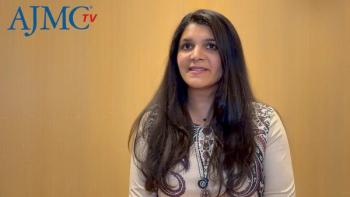
- June 2025
- Volume 31
- Issue Spec. No. 7
- Pages: SP418-SP420
Value-Based Care Calls for Putting Novel Therapies Closer to Patients
Key Takeaways
- Value-based care in oncology emphasizes access, outcomes, and affordability, with patient empowerment and clinical trials being crucial components.
- CAR T-cell and bispecific therapies have revolutionized treatment, but financial toxicity and accessibility challenges persist.
Coverage from IVBM Princeton, held May 8, 2025.
The last time The American Journal of Managed Care (AJMC) hosted a meeting in Princeton, New Jersey, was 2014, as millions of Americans were gaining health coverage under the Affordable Care Act—some for the first time in their lives.
Across health care, people were trying to grasp a new concept called value-based care, which focused on delivering just the right amount of treatment and making sure patients were screened for conditions such as cancer or diabetes before they became unmanageable.1 The idea of measuring doctors or hospitals on whether patients had a good experience was coming—and for some, that was scary.2
More than a decade later, as AJMC’s Institute for Value-Based Medicine® met on May 8, 2025, in Princeton, New Jersey, the fruits of value-based care are everywhere. But it’s still a term that’s hard to define, said Ed Licitra, MD, PhD, an oncologist-hematologist at and CEO of Astera Cancer Care, which has 100 providers across New Jersey.
“My journey in value-based care started about 10 years ago, when we started thinking a lot about value-based care before it was even defined,” Licitra said. “I can’t even tell you that today that it’s truly been defined. If you ask 100 people, ‘What is value-based care in oncology?’ you might get a lot of different answers.”
For Licitra, value-based care means providing access to care, driving the best clinical outcomes, and driving affordability in the health system. He focused on those priorities to moderate the opening discussion, “Measuring What Matters: Defining Value and Ensuring Affordable Access in Modern Oncology.”
Joining Licitra were:
- Coral Omene, MD, PhD, medical oncologist and program director of Breast Cancer Disparities Research at Rutgers Cancer Institute of New Jersey (CINJ) associate professor of medicine at Robert Wood Johnson (RWJ) Medical School at Rutgers University, in New Brunswick;
- Benjamin Roman, MD, MBA, MSHP, a head and neck surgeon at Memorial Sloan Kettering (MSK) Cancer Center in New York, New York; and
- Shannon Woerner, MBA, AOCNP, ANP-BC, vice president of clinical operations at Astera Cancer Care.
Ensuring access, good outcomes, and affordability are all related, said Licitra, who asked, “How do we actually create models of care, or how do we create ways of caring for [patients with cancer] that creates better affordability for care?”
Woerner explained that today, patients have an active role in guiding their own care. At Astera, once a newly diagnosed patient has an initial consult with their oncologist, the education process begins. Patients meet with nurse practitioners to learn what therapies they will receive, what adverse events to expect, how the schedule will work, and what medications they will take at home.
“That discussion is an opportunity for us to introduce the care team,” she said. Patients will likely have met their physicians, but this affords a chance to meet the broader team of triage nurses, nutritionists, and social workers.
Patients are encouraged to ask questions, Woerner said. “It’s an opportunity to connect with them and their families, to be able to say that we’re going to get you through this.”
Everyone has a role to play in driving clinical excellence, Licitra said, so empowering patients from the start matters. “And ultimately, it delivers a better outcome for patients,” he said.
Omene agreed, and she made the point that would be a theme for the evening: Ensuring access, better outcomes, and affordability means bringing the best science to their doorstep. That includes clinical trials, which she said are readily available Rutgers CINJ, which was days away from opening a $1.5 billion stand-alone cancer hospital, the Jack & Sheryl Morris Cancer Center (The Morris Center) in New Brunswick, New Jersey.
At one time, it was standard for patients in New Jersey to look to New York, New York, or Philadelphia, Pennsylvania, if they had received a cancer diagnosis. But over 20 years, both the state and major health systems, including those that would become part of RWJ Barnabas Health, have invested millions to create an infrastructure that allows most patients to be treated close to home.3
“We have many clinical trials as a major [National Cancer Institute] Comprehensive Cancer Center,” Omene said. “Not only are we able to offer [trials] to patients who come to us at our New Brunswick site, but we also have a very seamless, integrated partnership with our affiliate sites in the Barnabas health system.”
When discussing access, proximity is key. “That helps with access to getting all these therapies that they otherwise may not have been able to get as easily,” she said.
When discussing clinical excellence and value, Roman said, “I tend to fall back on Michael Porter’s framework, which defines value as the outcomes of care divided by the cost.”
Thus, better outcomes offer one way to improve value, but lowering costs without compromising outcomes is another. “At Memorial Sloan Kettering, I think we have a reputation for excellent outcomes [and] excellent quality of care. I don’t think we have a great reputation for saving costs,” Roman said.
Today, through MSK Care Partners, the cancer center works with existing oncology practices to deliver world-class care without requiring patients to travel. MSK operates this network in nearby places such as Connecticut and Lehigh Valley, Pennsylvania, but also as far away as Miami, Florida.
Collaborations recognize “you can’t do it alone,” Licitra said. Astera works with MSK but also with start-ups, such as Thyme Care.
Woerner explained how Thyme Care started with a focus on virtual patient navigation but now helps practices address medication waste and palliative care. Other partnerships allow Rutgers CINJ or MSK to bring clinical trials to underserved communities, where patients are challenging to enroll. Roman noted that New York state has invested $188 million to help MSK and Jamaica Hospital Medical Center open a comprehensive cancer center in Jamaica, Queens (a neighborhood in the borough of Queens in New York, New York).
Research shows that addressing patient education, transportation, and navigation are the keys to getting patients on trials, Omene said. And community outreach matters. “It’s not enough to open the trials,” she said. “Especially when you speak about the Black community that has generations of trauma, of why there’s a mistrust right in this country for the health system…there are many layers that you have to go through just to get them to participate and enroll in trials.”
Licitra turned the discussion to cost. He invited Woerner to share her efforts to develop a nurse triage system to manage symptoms and keep patients from heading to the emergency department. Roman shared how MSK experts offer second opinions on cases, using custom assays to create more personalized treatment. Often, MSK can de-escalate how intensive an intervention will be so that patients can be treated at a lower cost.
A major challenge is the cost of specialty drugs, which Licitra said has forced a rethinking of other parts of cancer care. If costs cannot be contained, he said, “I’m not sure exactly...what the future looks like.
“Controlling health care costs comes in many shapes and sizes,” Licitra added.
Optimizing Care Models for Chimeric Antigen Receptor T-Cell and Bispecific Therapies
Joanna Rhodes, MD, director of the lymphoma program at RWJ University Hospital, assistant professor at RWJ Medical School, and system head for lymphoma at RWJBarnabas Health, moderated a discussion on the rise of novel treatments, including chimeric antigen receptor (CAR) T-cell therapy.
Joining her were:
- Ogechukwu Egini, MD, MS, a hematologist-oncologist at Rutgers CINJ and an assistant professor at RWJ Medical School;
- Sridevi Rajeeve, MD, a myeloma specialist and cellular therapist at MSK Cancer Center; and
- Claire Yun Kyoung Ryu Tiger, MD, PhD, a medical oncologist at Rutgers CINJ and an assistant professor at RWJ Medical School.
“We know that bispecifics and CAR T have truly changed overall survival and impacted our patients’ care greatly, but there are a ton of barriers,” said Rhodes, who invited Egini to compare today’s therapies to the standard of care in the days before the first CAR T-cell therapy, tisagenlecleucel (Kymriah; Novartis Pharmaceuticals Corporation), was approved in 2017.4
“These are patients who were always in the hospital,” he said. The cost of nursing time and physicians’ time all added up. “Then you think about this one-and-done therapy. For patients who respond, it’s half a million [dollars],” he said.
Expensive? Yes, but for Egini, the shift to CAR T-cell therapy was a “no-brainer” from a cost perspective. “Useful life is created when this succeeds,” he said. The arrival of bispecific therapy has also allowed patients “to live better, be more productive, contribute to the economy, and have a better quality of life.”
The story is similar in multiple myeloma, Rajeeve said, as successive clinical trials have brought 2 approved CAR T-cell therapies, idecabtagene vicleucel (Abecma; Bristol Myers Squibb) and ciltacabtagene autoleucel (Carvykti; Janssen Biotech, Inc), into earlier lines of care. Responses to CAR T-cell therapy in myeloma have not been as durable as those seen in lymphoma, she noted, but that hasn’t reduced demand. “Patients are actively coming to us, requesting, even demanding,” treatment in the second and third line because they know about clinical trials, Rajeeve said.
Even though CAR T-cell therapy is curative only for a subset of patients with myeloma, “it does remain the choice for a lot of patients who are coming to us with high-risk disease” because it offers a chance to have an extended treatment holiday, she said. Younger, functional high-risk patients are thus given priority.
Rhodes asked Tiger to discuss barriers to CAR T-cell therapy or bispecifics in lymphoma and what factors drive decisions about therapy. Tiger said bispecifics are easier to tolerate, so she evaluates both disease burden and functional status as well as distance from the clinic and availability of a caregiver. Patients must have a caregiver available in order to receive CAR T-cell therapy because they will need someone to look for complications from toxicities, including cytokine release syndrome (CRS). For frail patients, bispecifics are a better choice.
“We are trying our best to make CAR T more accessible to patients who are able to undergo this because it is really much easier for patients if they can just do a one-time therapy and have a very durable response,” Tiger said.
Rhodes guided a discussion on how larger cancer centers interact with smaller community clinics in managing patients as well as new guidelines from the National Comprehensive Cancer Network (NCCN) for prophylactic tocilizumab (Actemra; Genentech) to mitigate CRS. For example, Rajeeve said the step-up dosing for bispecifics may be done at MSK, but later doses are done close to the patient’s home.
“I want to drive home that prophylactic tocilizumab does not take care of CRS in its entirety,” Rajeeve said, adding that giving prophylactic tocilizumab can put patients at higher risk of immune effector cell–associated neurotoxicity syndrome (ICANS)—although MSK has not seen this so far.
“People are breaking through,” she said. “They need to be plugged into the health care system, with or without remote patient monitoring.”
Balancing Innovation and Affordability in Multiple Myeloma
Advances in treating multiple myeloma have not come without costs, panelists agreed during a discussion moderated by Joshua Kra, MD, a hematologist-oncologist at Rutgers CINJ and at University Hospital in Newark, New Jersey.
Joining Kra were:
- Mansi Shah, MD, a hematologist-oncologist and clinical director of multiple myeloma at Rutgers CINJ and an assistant professor of medicine at RWJ Medical School;
- Hussam Eltoukhy, MD, a hematologist-oncologist at RWJBarnabas Medical Group in West Long Branch, New Jersey; and
- Harsh Parmar, MD, a medical oncologist specializing in multiple myeloma and other plasma cell disorders at John Theurer Cancer Center at Hackensack University Medical Center, part of Hackensack Meridian Health, in New Jersey.
Kra asked panelists about their general approach with newly diagnosed patients before diving into the challenge of financial toxicity. Is anti-CD38 therapy, whether daratumumab (Darzalex; Janssen Biotech, Inc) or isatuximab-irfc (Sarclisa; sanofi-aventis US, LLC), used for both transplant-ineligible and -eligible patients?
Parmar said if patients are transplant eligible, his institution works to avoid the standard daratumumab combinations for many reasons, notably that Hackensack has a higher goal than other centers for stem cell collection and that pretreatment with anti-CD38 regimens can interfere with that priority. “But when it comes to the transplant-ineligible patients, the data are pretty strong, whether you’re looking at the IMROZ [NCT03319667] or CEPHEUS [NCT03652064] trials, where the estimated [progression-free survival] is close to 90 months,” 5,6 he said. “For those subsets of patients, we have been doing [quadruple] therapy,” which includes the anti-CD38 therapy plus bortezomib (Velcade; Millennium Pharmaceuticals, Inc), lenalidomide (Revlimid; Bristol Myers Squibb), and dexamethasone.
“For me, in first-line therapy for myeloma, it really isn’t a question of [whether] an anti-CD38 antibody is going to be used,” Eltoukhy said. “It’s a question of which one and with what regimen.”
For transplant-ineligible patients, Eltoukhy prefers the MAIA trial (NCT02252172) regimen,7 which uses daratumumab with lenalidomide and dexamethasone but skips the bortezomib. “By taking out the proteasome inhibitor, we’ve seen really significant decreases in toxicity,” which is especially important for older patients who can develop neuropathy, he said.
The anti-CD38 regimens do create hematological toxicity, which Eltoukhy said he finds manageable with prophylactic antimicrobials. He also said that he finds the IMROZ data “interesting” and uses this therapy in younger patients when he sees high-risk cytogenetics and seeks a more robust response.
Age is very much a driving factor in decision-making, he said. “We know whether you [use] a 4-drug or a 3-drug regimen, you’re not going to cure it, but you will prolong survival. It’s really a patient-by-patient approach.”
Comorbidities also affect drug selection, Shah said. “It depends on how frequently they want to come to the infusion center. Do they prefer an IV [intravenous administration]? Do they prefer injections?” Quality-of-life considerations play a role, she said.
“It’s fascinating to hear,” Kra said. “We all practice in New Jersey—it’s such a small state. And there’s such variability.” And yet, “we all have data to support” these different approaches.
Kra then invited the panelists to discuss the challenge of financial toxicity.
“I have patients sometimes bargaining with me,” Shah said. “‘Can I get this every 2 months? Every 3 months?’ Co-pays add up, especially for patients relying on Medicare who do not have supplemental insurance. Others ask [whether] they can be treated at home, saying, ‘Just coming to your center takes a big chunk out of my day.’”
Eltoukhy said the financial disparities in New Jersey—where some are very rich and others very poor—were evident among the populations the panelists served. In Monmouth and Ocean counties, where Jersey Shore real estate prices have soared, Eltoukhy runs into fewer financial barriers than those practicing in Newark or New Brunswick.
There is one common challenge, however. Although Eltoukhy sees far fewer denials for daratumumab than he once did, “the doctor is always ahead of the insurance company,” he noted.
Parmar said he has few insurance issues in Hackensack, located across the Hudson River from New York, New York, in comparatively affluent Bergen County. However, recent trials for quadruple therapy do not address the need for limited-duration therapy, which would cap patient costs. This concept “needs to be explored to reduce the financial burden,” he said.
TRANSPLANT vs QUADRUPLE THERAPY. Kra asked about the ongoing role of autologous stem cell transplant (ASCT), for years a mainstay of myeloma treatment. Parmar said that in the context of so many emerging therapies—some of which cost up to $500,000—the question should be, “Is transplant replaceable?”
Given how well ASCT works for $150,000 to $200,000, Parmar said the issue should be when to perform a transplant vs give CAR T-cell therapy.
“Transplant works best when done in the up-front setting; its efficacy drops with each line,” he said. “CAR T [is] known to be efficacious even in fourth line.” So, Parmar said, if the question is whether CAR T-cell therapy should replace transplant, “I would be uncomfortable saying that.”
Eltoukhy said when looking at value, he also would not consider forgoing transplant for CAR T-cell therapy until more data are available and until there’s a better understanding of where bispecific therapy fits into sequence. He agreed more long-term data are needed.
Shah noted the value calculation must include a patient’s time. Both CAR T-cell therapy and transplant require significant time away from work for the patient and may require a caregiver. If the patient is a breadwinner, that’s also a consideration.
“The good thing is that patients are living longer; they are able to contribute and participate in society,” Shah said. Reducing toxicity to prevent hospitalization, limiting trips to an infusion center, and using biomarkers to determine which patients can come off therapy are all important issues.
Eltoukhy agreed that measuring minimal residual disease is the future, but it’s still not fully understood how to use it.
Shah said she hopes myeloma could someday be like diabetes, where medicine figures out how to treat it like a chronic condition. “The thing about myeloma, you have to keep your foot on the brakes so [it] doesn’t come back,” she said.
Collaborating With Pharmacy to Find Value
Three pharmacists closed the evening with a discussion of how working closely with an oncology pharmacist can help patients avoid adverse events that add costs to the system. Moderator Eileen Peng, PharmD, vice president and chief administrator and pharmacy officer for Astera, joined panelists David Awad, PharmD, BCOP, a pharmacy manager for The Morris Center, and Melissa Pozotrigo, PharmD, BCOP, a senior clinical oncology pharmacist at OncoHeath.
Peng asked fellow panelists to describe the pharmacy team’s role in delivering CAR T-cell therapy and bispecifics in an outpatient setting. Awad noted that moving these treatments close to where patients live has multiple benefits for patients but that educating frontline providers—especially nurses—will be key to managing toxicities and ensuring patients stay on medication. Pharmacists must work closely with the rest of the team to develop a care plan that everyone understands.
“If we cured their cancer, but they died of E coli bacteria because they didn’t take one medication for 5 days, then we didn’t really accomplish anything,” Awad said.
Pharmacists are on the front lines of working through insurance issues, which brought Pozotrigo into the mix because her role is to review therapies for medical necessity. “Our goal, and the whole pharmacy department goal here, is to expedite these cases, get them reviewed and turned around as quickly as possible so there are no delays in therapy,” she said.
NCCN guidelines and specific FDA indications matter most here. If neither calls for approval, Pozotrigo said that OncoHealth checks the most recent peer-reviewed literature for guidance.
PRACTICAL STEPS AND PROTOCOLS. Awad had a checklist of items to ensure that drugs are waiting for patients when they reach their appointment. Making sure the drug is available tops the list. If a patient is receiving CAR T-cell therapy and needs tocilizumab, should the clinic wait for prior authorization?
“Pharmacists are very useful in writing protocols in a stepwise fashion, laying everything out as to dosing for each grade,” he said. Pharmacists can list symptoms and educate stakeholders. They can help when patients have infusion reactions and aid response if a patient has a cardiac arrest. “But just being at the bedside and being present, saying, ‘What can I do for you? Can I draw up this vial of dexamethasone? Does that make it easy for you so you could be with the family?’” he said.
Pozotrigo said working to speed approvals takes many forms. Some payers will allow certain automatic approvals, and those should be arranged. Peng added that pharmacists can eliminate delays by writing thorough care plans that address every scenario.
Awad noted that comprehensive medication reviews can help prevent reactions and encouraged oncologists to remember they know much more than just cancer medications. “A lot of these patients are going to be on multiple drugs outside of their malignancy care,” he said. “Is there a drug interaction that causes sedation or something that might be looking like ICANS, for example?”
Peng noted that the pharmacist’s role has changed in recent years. It’s no longer just dispensing drugs—it’s making sure guidelines are followed “so we will get paid.” It’s helping financial counselors with co-payment assistance. It’s making sure patients have backup support. Awad said a medical necessity letter from a pharmacist may carry more weight with the insurer than one from the nursing staff. And he said pharmacists are familiar with real-world data that could support use if the patient’s need doesn’t precisely fit the FDA indication.
Finally, Awad said he sees pharmacists playing a bigger role in helping more therapies—including bispecifics—move out of the clinic so patients can take them at home. Simplifying regimens makes this easier.
Driving to a hospital or clinic and sitting in an infusion chair “is time away from everything else that they want to do; that makes their psychology about their whole disease so much worse. It’s debilitating,” Awad said.
“I would love to see in the next 5 years moving some of these therapies to the home, especially in the maintenance setting,” he said. “Why can’t we just give these at home and let the patient live the rest of their life?”
References
1. United States Preventive Service Task Force. A and B recommendations. Accessed May 27, 2025. https://www.uspreventiveservicestaskforce.org/uspstf/recommendation-topics/uspstf-a-and-b-recommendations
2. CMS releases first-ever Hospital Compare STAR ratings. News release. CMS. April 16, 2015. Accessed May 27, 2025. https://www.cms.gov/newsroom/press-releases/cms-releases-first-ever-hospital-compare-star-ratings
3. Caffrey M. Building a patient-centered cancer center from the ground up. AJMC. October 13, 2021. Accessed May 15, 2025. https://www.ajmc.com/view/building-a-patient-centered-cancer-center-from-the-ground-up
4. Kymriah. FDA. Updated September 3, 2024. Accessed May 27, 2025. https://www.fda.gov/vaccines-blood-biologics/cellular-gene-therapy-products/kymriah
5. Facon T, Dimopoulos MA, Leleu XP, et al; IMROZ Study Group. Isatuximab, bortezomib, lenalidomide, and dexamethasone for multiple myeloma. N Engl J Med. 2024;391(17):1597-1609. doi:10.1056/NEJMoa2400712
6. Usmani SZ, Facon T, Hungria V, et al. Daratumumab plus bortezomib, lenalidomide and dexamethasone for transplant-ineligible or transplant-deferred newly diagnosed multiple myeloma: the randomized phase 3 CEPHEUS trial. Nat Med. 2025;31(4):1195-1202. doi:10.1038/s41591-024-03485-7
7. Facon T, Moreau P, Weisel K, et al. Daratumumab/lenalidomide/dexamethasone in transplant-ineligible newly diagnosed myeloma: MAIA long-term outcomes. Leukemia. 2025;39(4):942-950. doi:10.1038/s41375-024-02505-2
Articles in this issue
6 months ago
Breast Cancer and the Use of Predictive GenomicsNewsletter
Stay ahead of policy, cost, and value—subscribe to AJMC for expert insights at the intersection of clinical care and health economics.













































